They say eat like a local, and boy howdy, can I do that. Especially when it comes to traditional Malaysian desserts in Langkawi, Malaysia. However, I didn’t become a Langkawi dessert connoisseur overnight. It took time. From abandoning the desperate, expatriate search for my beloved Fig Newtons and Moon Pies to accepting my fate of a future snacking on boring discs of flavorless ‘digestives’ to the fascinating discovery of traditional Malaysian desserts and Malaysia kuih, Langkawi style.
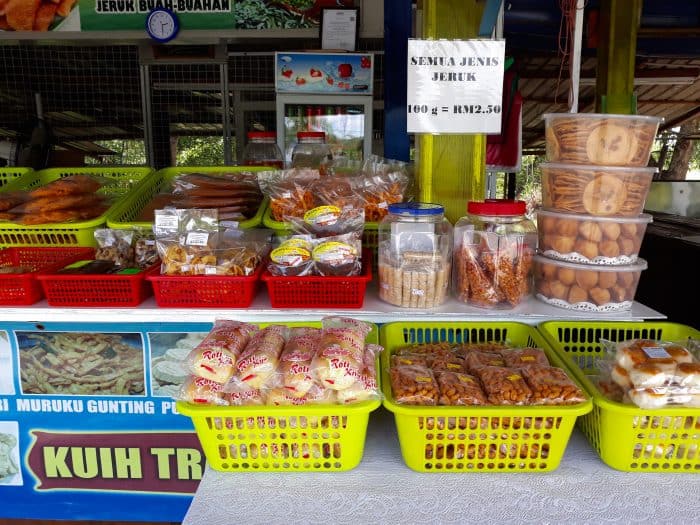
The name kuih is a big umbrella of love that covers an abundance of tasty sweets as well as savory morsels. But for the sake of this blog post, we’re going to stick with the sweet stuff. And if it looks or tastes like dessert, then by golly in my book it qualifies as ‘dessert’. But by definition, kuih is a bite-sized snack or dessert food.
It can include cakes, cookies, biscuits and the like, and is usually made from rice flour or glutinous rice. But all bets are off when it comes to varied ingredients, secret family recipes and the creativity of Malaysian cooks. And for goodness sakes, one person’s bite size is another person’s family serving, so don’t feel too guilty if you can sock away a whole lot of ‘bite-sizes’ all by yourself. Because I certainly can.
Here are 13 traditional Malaysian desserts (and Malaysia kuih) that hit the flavor mark with me and I think you’ll love them as much as I do. No surprises either, I promise. No sneaking in chopped onions on colorful custards or any of that exotic nonsense. Just good old fashioned not-too-sweet traditional Malaysian desserts and kuih that will give you a taste of traditional local flavor and make your sweet-tooth a happy camper. Enjoy!
1. Kuih Peneram (or Coq Meneram)
A donut by any other name would taste as sweet. That’s right, Peneram is Malaysia’s version of the donut. It is also called coq meneram by Kedah locals. Other old school monikers include Kuih Denderam and Kuih Telinga Keling. The ‘Kuih Telinga Keling’ version being less popular due to its now deemed derogatory connotation in reference to the long ago ethnic Indians who often sold them.
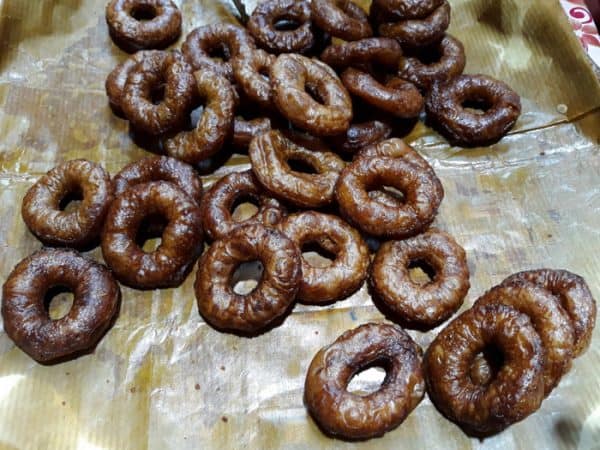
This South Indian specialty is made with rice flour and brown sugar cooked with Pandan leaves. As a street food, it’s usually made onsite from rolled out dough, cut with a makeshift cookie cutter, and deep fried, as the Peneram tastes best when fresh from a sizzling wok. You can also find these tasty donuts being pre-made and packaged by locals at their homes, and sold at various shops around Langkawi.
View this post on Instagram
2. Kuih Loyang
The can’t-eat-just-one Kuih Loyang is a delicate snack that doesn’t last long once it has hit greedy fingers like mine. Loyang are said to be of Swedish and Norwegian origin, but variations of the flower-shaped kuih have made their way around the world from Sweden to Sri Lanka to Malaysia, where they are also known as Kuih Rose, Kuih Goyang and ‘Beehive Cookies’. ‘Loyang’ refers to the metal typically used in the mold; loyang means brass in Bahasa Malayu.
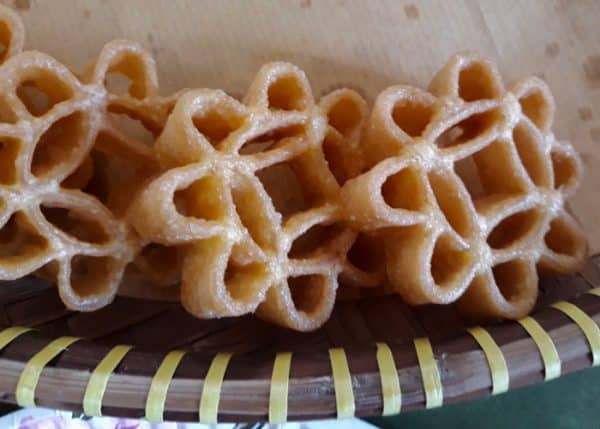
Kuih Loyang are made by using an intricately designed metal mold which is heated in oil and then dipped in a batter of flour, coconut milk, sugar and eggs. The mold is then re-dipped in the hot oil until the batter forms a crispy shell around the design and then the mold is removed, leaving the floating kuih to finish frying on its own. It’s a quick but exacting process to keep the fragile shape from falling apart, but the end product looks lovely on a plate and tastes even more lovely.
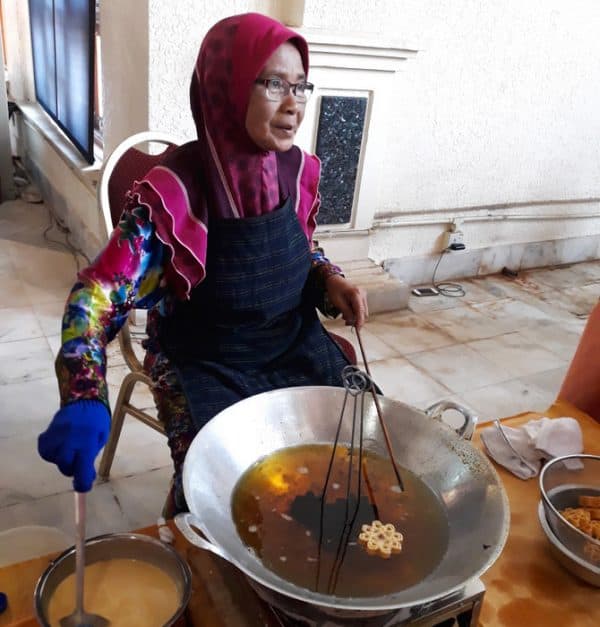
3. Apam Balik
The popular Apam Balik is easy to spot at the various night markets around Langkawi. Also, referred to as ‘Sweet Puff’, Turnover Pancake, Martabak Manis and several other names, it’s basically a thin pancake filled with sugary ground peanuts and a dollop of canned sweet corn. The batter is a mixture of flour, eggs, sugar and coconut milk, which is poured into saucer shaped molds and cooked over an open flame. Once it’s cooked, it is folded over and ready to eat.
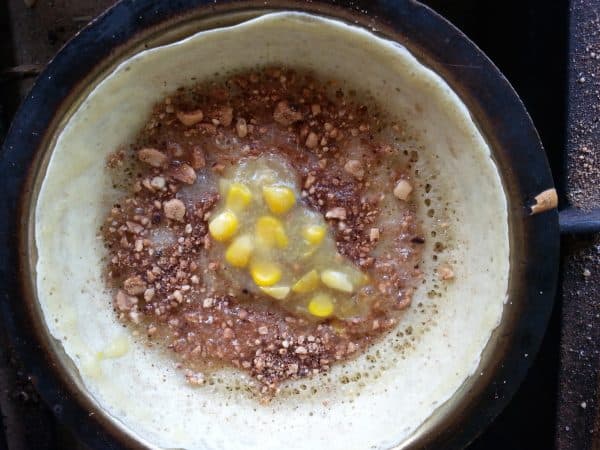
Look for Apam Balik in two sizes; the large family size is thicker and more cake-like than the crisper smaller version. Apam Balik has also been declared a heritage food by the Malaysian Department of National Heritage, so be sure to give this historic dessert a try!
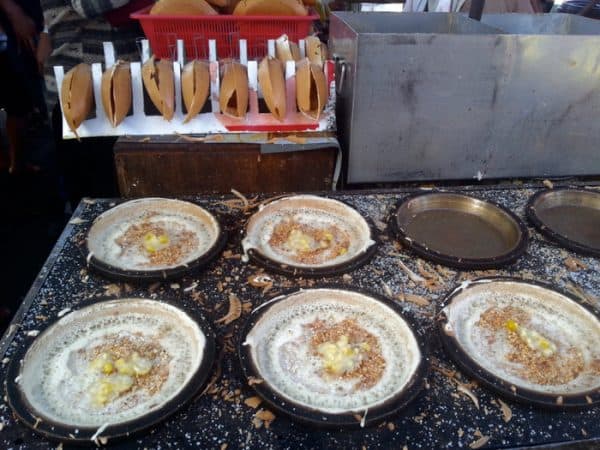
4. Kuih Keria
Another local donut variation is Keria, which is made from mashed sweet potatoes and rice flour. Although popular during Ramadan, there are a few locals who make and sell these year round. Keria are handmade from a hand-flattened ball of sweet potato dough and a center hole is poked out prior to deep frying. Post sizzling wok, Keria are coated with simple syrup or sprinkled with powdered sugar. This sweet treat is also known as Kuih Gelang, because the dough is shaped like a gelang (bracelet).
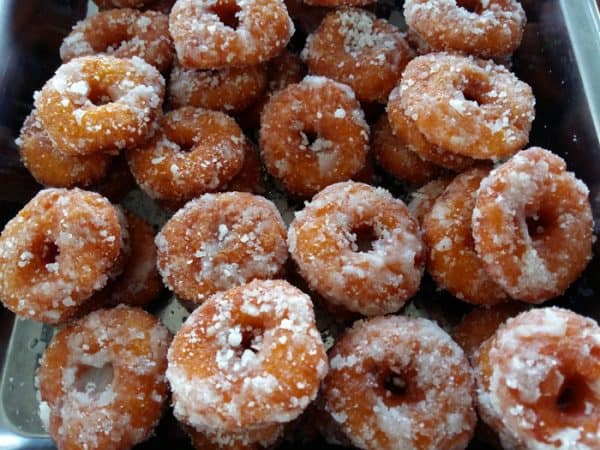
5. Kuih Bunga Pudak
This mysterious little kuih is said to have originated in Kedah state and is named after the Pudak tree; a scented flowering tree. Its creation is a bit of Malaysian sleight of hand and culinary magic. The ‘skin’ of the Bunga Pudak is made with a glutinous flour mix heated in a dry, hot wok. Once the powdery concoction becomes more solid, a spoonful of colorful coconut and sugar mix is added to the center.
The edges of the glutinous flour are then folded over, heated about 10 seconds in a frying pan and walah! A Kuih Bunga Pudak is born. This delicate morsel nearly melts in the mouth with little chewing involved. Like I said, it’s mysterious, but tasty none the less. It is also not very common, so if you get the opportunity to taste test, don’t pass it up.
View this post on Instagram
6. Kuih Dangai
Originating from the state of Kedah (so I’ve been told), or at the very least Northern Malaysia, Dangai is made from glutinous rice, brown sugar and shredded coconut. The batter is poured in two-sided, eclair-shaped molds, then once baked and removed from the mold, the Dangai halves are folded over to create an elongated whole. From outward appearances, it may look a bit dry, but the center stays moist and tasty. Very popular among traditional Malaysian desserts fans.
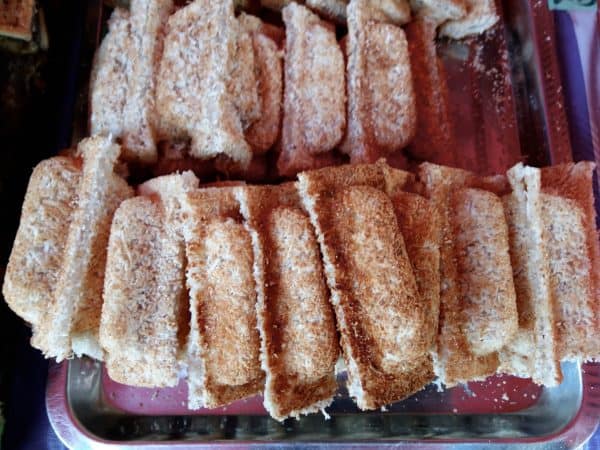
7. Buah Melaka
Buah Melaka is pure bite-sized decadence. The dough is made with glutinous rice flour, a bit of tapioca (or corn) flour to make the tiny dough balls slightly harder, and flavored with Pandan leaves. But the magic comes in the form of a chunk of Palm Sugar tucked inside, before it is rolled in shredded coconut and baked. One bite of a Buah Melaka and the melted sugar just oozes into your happy mouth. Melaka claims it as the Malaysian state of origin under the name of Onde-Onde, but you will also find Buah Melaka called Kuih Melaka, Kelepong and in Indonesia, Klepon.
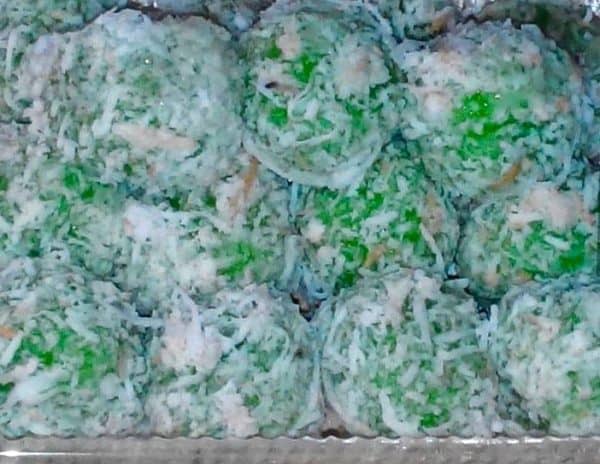
8. Putu Mayam or Putu Mayong
Another local Langkawi favorite, Putu Mayam (also known as Putu Mayong) is of Tamil origin. This lace-like creation can be served up as a dessert with palm sugar and grated coconut or with just about anything, especially curries. Made from rice flour, the dough is hand pressed through a wooden sieve, creating long stringy noodles.
The vermicelli-sized noodles are delicately squeezed out in a circular motion onto a cloth covered rattan basket creating a lacy pattern. Several baskets get steamed at the same time ensuring that there is plenty of Putu Mayam to go around. Although there are modern sieves (also called sevanazhi) available, locals will attest to the superior flavor created with the traditional wooden sieve.
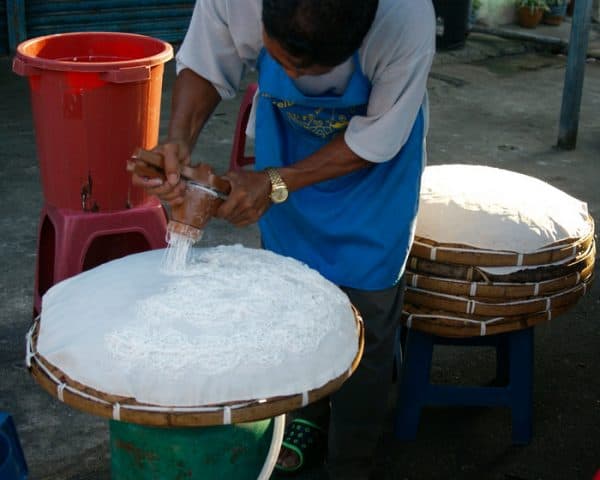
9. Kuih Karas
A traditional kuih from the state of Kedah, Kuih Karas is created from a liquid-y batter of rice flour and sugar. The batter is drizzled through a sieve style container (or a coconut shell with many holes) into a wok full of hot oil. Drizzled artfully in a circular motion for a few seconds, the resulting nest of flour strings float atop the oil and fry to a light golden brown.
The process takes less than 60 seconds as the newly made Karas is folded into quarters and removed from the hot oil to drain. Not only interesting to look at, the crispy Karas has a light sugary flavor and is perfect as a munch-able tea snack.
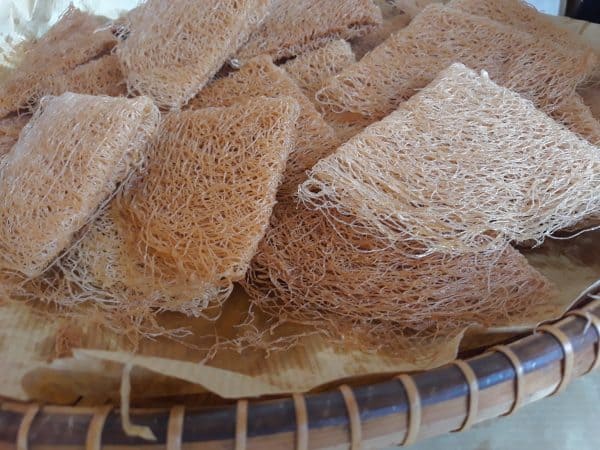
View this post on Instagram
10. Kuih Bahulu
If you’re a fan of madeleine cakes, you’re going to love Bahulu! Also, known as Kuih Baulu and Kuih Bolu. The Bahulu name comes from the word ‘bolo’ which is the Portuguese word for cake. These airy little cakes are a big hit with locals and tourists alike. The cake batter is heavy on eggs which makes it much fluffier than ordinary cakes. Bahulu are typically baked in brass or metal molds shaped like fish, flowers, fruit or even sea shells giving the small cakes a festive shape and certainly add to the fun factor of snacking.
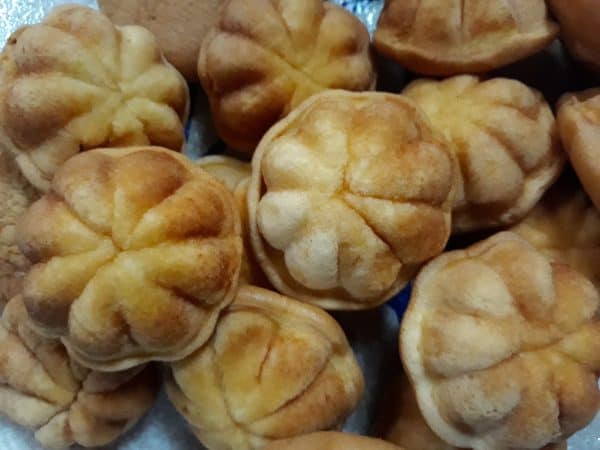
11. Dorayaki
Dorayaki are of Japanese origin and have a history as far back as the early 1900s. During the late 1970s a few Japanese supermarkets opened in Malaysia and are credited with introducing Dorayaki to Malaysian taste buds. However, I suspect the initial introduction came much earlier during World War 2. But that’s just my theory. At any rate, Dorayaki now makes a regular appearance at night markets across Langkawi.
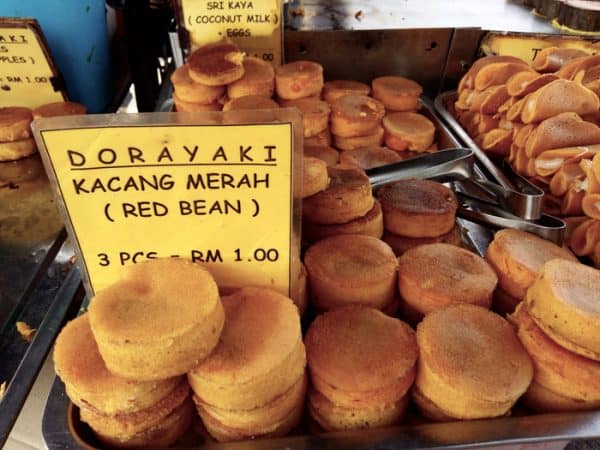
Cooked on a grill, Dorayaki is made from two small layers of sponge cake batter, with a sweet red bean or kaya coconut spread inside the two layers. Originally named Dorayaki due to its gong-like shape, because ‘dora’ is the Japanese word for ‘gong’. These bite sized pastries hold their freshness for a few days, so stocking up for the week is not uncommon.
12. Tokiyoo (Tokiyao)
The Tokiyoo is very similar to the Dorayaki and is in fact its original shape. The original Japanese Dorayaki consisted of only one layer until 1914, when it then became its present hockey-puck shape. How it became known in Langkawi and other parts of Malaysia as Tokiyoo is a mystery, but it could again have something to do with World War 2. The Japanese military were definitely present in Langkawi in 1941 and 1942. Tokiyoo is made from a small pancake folded over a plop of kaya or other flavorful jams and stays moist and snack-worthy for several days.
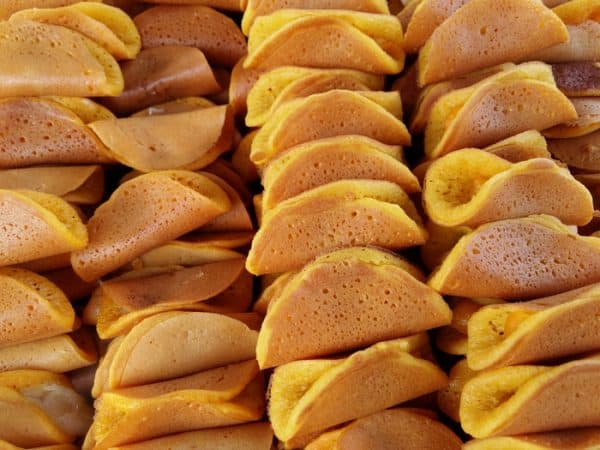
13. Putu Buluh
Another night market favorite, of the traditional Malaysian desserts, is Putu Buluh (bamboo sweet rice), which is also called ‘Indian Pop’. Of Tamil origin, Putu Buluh is ground rice and coconut packed into bamboo cylinders and steamed. This creates a cylindrical shaped sweet that is served up with additional grated coconut and palm sugar. Some venders use metal tubes or even paper cups instead of the traditional bamboo, so be on the lookout for the different Putu Buluh cooking techniques, they can vary from location to location.
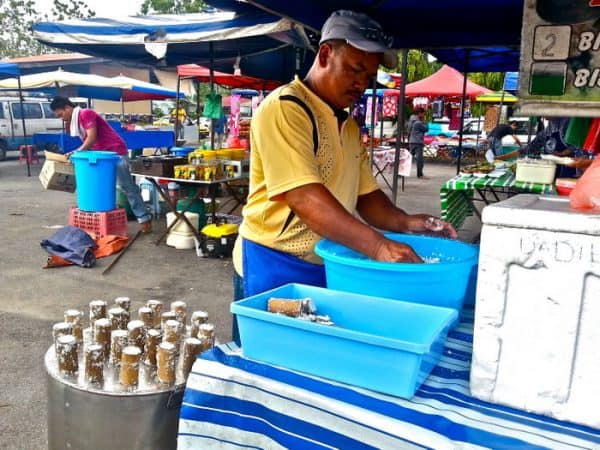
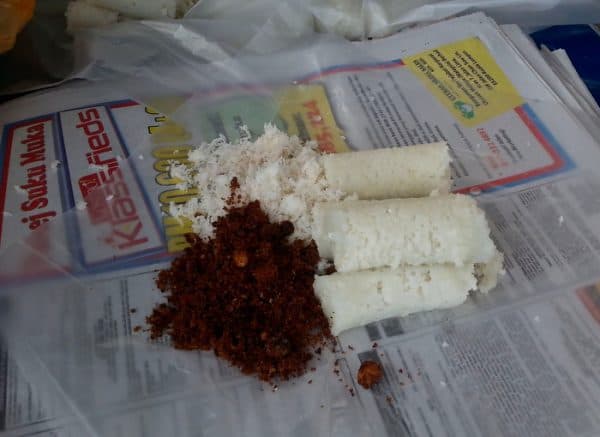
So, there you have it! A baker’s dozen of 13 delicious traditional Malaysian desserts to try in Langkawi, Malaysia. But trust me, the selections go well beyond a mere 13. There are many more desserts and kuih specialties to discover in Langkawi as well as the rest of Malaysia. Keep your eyes open at night markets, roadside vendors and mom and pop shops and you are sure to discover plenty more. Happy hunting!

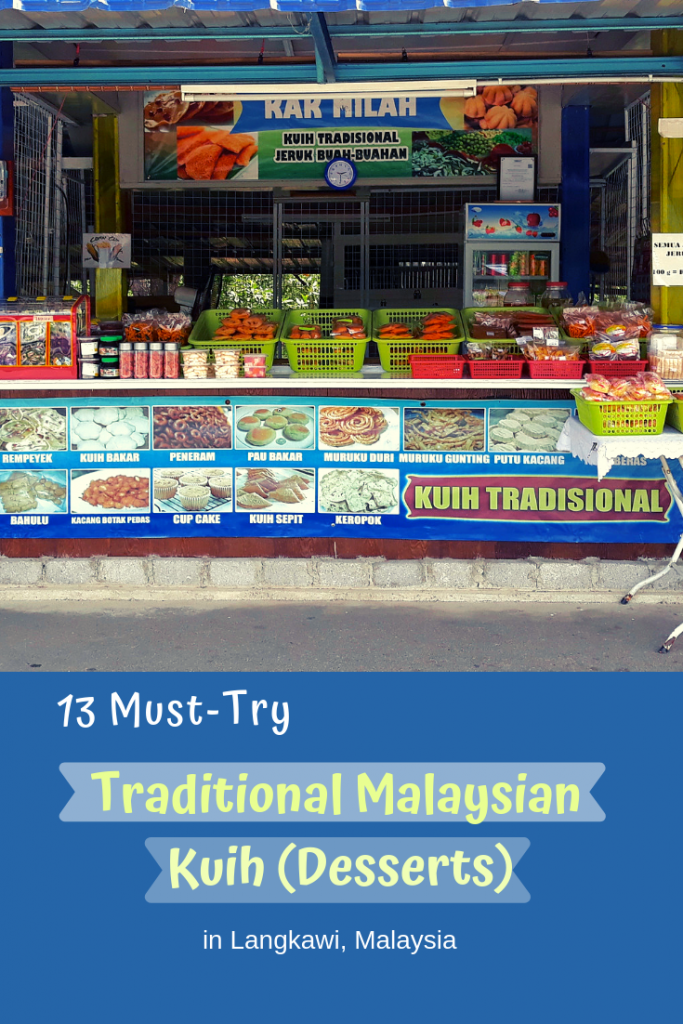

Ah it kills me I’ve still never been to Malaysia! Mmmm the Kuih Keria doughnuts look immense! I don’t have much of a sweet tooth, but I’d sell out in seconds for those!
Malaysia is quite eclectic Tom. It’s so much more than KL and Penang, tons of nooks and crannies and plenty of ‘non sweet’ food to try too. :D
Buah Melaka and the various Putus are very much like Filipino sweets, too. This is our Malay blood that bonds us!
I’m definitely going to do research for a food comparison blog next time I’m in the Philippines. Love how the histories overlap through food.
I love the idea of doing a search for the desserts of Malaysia. I like that you stuck with just sweet things. And didn’t want chopped onions in your desserts. The Kuih Loyang look almost too pretty to eat. So I am not surprised they are called “rose”. The Keria even might be healthy with the sweet potato base. I might want to try Bahulu as I recently discovered the best madeleine cakes. Certainly a great list of desserts to try.
Thanks Linda! I actually did buy a beautiful yellow custardy creation (that I mentioned) and I was so taken aback when I bit into that, that the memory really stuck with me. I had thought it was a sweet and it wasn’t. Not sure what it was actually, or why anyone would want to eat it. But when you are craving sugar and bite into onions it throws the brain circuits off a bit. It wasn’t the first time I have been tricked by something pretty, but this one was hiding near the donuts so I was sure it was sweet custard. :D So I thought I could help the sweet lovers out with this list of sure shots.;)
What a fun post to investigate. Your videos are mesmerizing. I think my favorite would be the Kuih Loyang, just going my description. It looks so light and tasty. Plus it’s so pretty. Whenever we move to new countries, I try to buy one or two new things a week at the store or market for us to try out. I especially like trying new fruits. Some things are a hit and some things, not so much. It’s fun to try though.
Hey Kathleen, thanks! Yes I think exploring the local culture through local food can be really interesting. I did try to tackle fruits here too and I almost got it 100% correct, except some confusion with Jackfruit and a couple of odd spellings that no one outside of the state of Kedah had seen before.
My goodness, how do you manage not to put on masses of weight with so many delicious desserts to try? I’ll always remember what Kuih means in Malaysia now. The ones I would personally like to try are Kuih Keria with the mashed sweet potatoe as well as the flowery Kuik Loyang.
I gained 5 pounds researching for this post. Not kidding. :D
I am not very familiar with Malaysian dishes and desserts, but I think I have tried something like Kuih Loyang. The one I tried wasn’t heavy and it was cooked the same as Kuih Loyang. I would like to try Kuih Peneram too
Now that is a serious list of desserts! Some are quite different than what we are used to, so paying attention to the ingredients are important. Buah Melaka sounds very interesting and Kuih Loyang looks so beautiful. I think Malaysia is definitely worth a visit to try all these out.
Wow! Never knew there were so many Malaysian Desserts! I’ve seen the Kuih Loyang and the Kuih Karas, but never tasted them. Also, Tokiyoo seems like a cake we also have in Portugal, named Guardanapo (Napkin) :)
Ha! I never tasted those before either because I thought for sure they were sardine flavored somethings. I would not have known they were desserts had I not seen the cooking demonstration they had at the Langkawi Craft Complex. I was so excited! And I love hearing about similar food items in other countries. The Portuguese have a definite history in Malaysia, so maybe my WW2 theory is way off.
I’m really glad to be reading this article after lunch! All those delicious-looking Kuih desserts are making my mouth water. Those Loyang and Keria treats look so pretty, and must taste amazing. A baker’s dozen indeed. Thanks so much for introducing me to these tempting desserts. I’m bookmarking this for future reference.
Some of them look (and taste) like works of art for sure. I was super excited to have had the recent opportunity to see the Loyang and Karas being made, had no idea they were made by hand, just assumed machine.
I’m a huge donut fan so the Kuih Keria and Kuih Peneram immediately got my attention. I’m very curious about the Kuih Karas, it looks and sounds very unique
The Peneram are especially addictive. They aren’t heavy either, so it’s easy to rationalize that ‘just one more’ is nearly calorie free. I have been known to wipe out a dozen in one guilt-free sitting :D.
Excellent research yet again Vanessa! What a lovely idea!
Thank you Lisa! Muah!